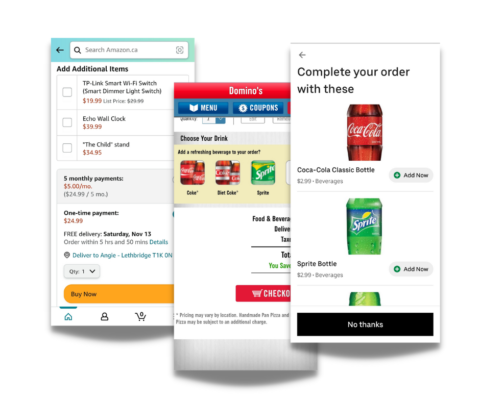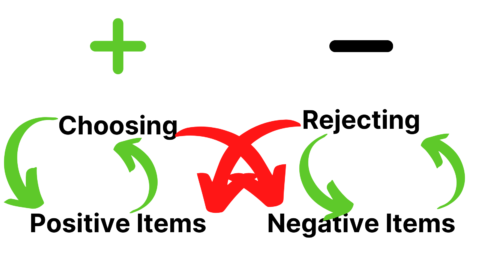Opt-in or opt-out?
Do sales increase if you present customers with a list of upsells to choose from?
If you make customers opt-out or deselect items, will you decrease buyer satisfaction?
Marketers will often tell you to always use opt-ins because opt-outs just upset customers.
But that isn’t always the case.
Psychology research suggests there’s a lot more nuance to these decisions. And the difference could be huge for customer loyalty, the customer lifecycle, and your bottom line.
Presenting Upsells To Buyers
While there are plenty of variations, ecommerce generally uses one of two methods:
Opt-In (Choosing Strategy):
Customers can choose what they’d like to buy from a list of upsells.
 Screenshots from Amazon.ca, Domino’s, and UberEats, November 2021
Screenshots from Amazon.ca, Domino’s, and UberEats, November 2021Opt-Out (Rejection Strategy):
Customers must remove or reject unwanted items from their cart before purchasing.
 Screenshots from Amazon.ca, iRobot, and Domino’s, November 2021
Screenshots from Amazon.ca, iRobot, and Domino’s, November 2021On the surface, these two tactics don’t seem all that different or complex, but research suggests the thought processes behind them are.
For example:
Question 1.
You’re building a petting zoo for your favorite hypothetical 5-year-old daughter to play in. Which animal baby will you put in it first?
a) Lambs
b) Kids (The baby goat kind.)
c) Chicks
Question 2.
You’re building a petting zoo for your favorite hypothetical 5-year-old daughter. Which one are you picking?
a) Poisonous Cobra snake
b) Black widow spiders
c) Piranhas
Question 3.
Your hypothetical daughter wants to turn the petting zoo into a Halloween zoo. Which animal are you replacing the cute animal with?
a) Poisonous Cobra snake
b) Black widow spiders
c) Piranhas
If the research holds (and I structured the questions right), you’ll likely find the first and third questions easier, faster, and a little more satisfying to answer than the second question.
Why?
The second question asks you to choose(+) a negative(-) option. There’s a mismatch.
In more dry language, researchers found that users (on a general population basis) make decisions faster and have less indecision when choosing (a positive action) desirable options (positive items) in a positive situation.
In a negative situation, we prefer to reject (a negative action) undesirable things (negative items).
Why?
Less indecision and interruption in the decision-making flow increases decision confidence.
 Chart/Angie Nikoleychuk
Chart/Angie NikoleychukWhy Action-Option Mismatch Matters
In the second question, there was a mismatch between the action and the item or result that threw you off guard. You were choosing(+) a negative(-) option in a relatively positive situation(+).
Just like your website.
And the effects can be long-lasting.
Research finds we’re usually more deliberate and careful when rejecting items. We pay more attention to our biases and attempt to be consistent.
It’s also important to note that when we reject a choice, we focus on the negative aspects of a product, service, brand, or individual rather than positive details that we would otherwise focus on when using a choosing strategy.
We also tend to engage in a bit of lying to ourselves. After we make a decision, we can reaffirm our choice and build our confidence in our decision by focusing on the negative traits.
“I’m delighted I didn’t choose the car that I originally wanted. The one I chose may not have all the features I wanted, but it’s much more affordable. It was a better choice.”
(In fun terms, this cognitive habit is sometimes referred to as our brains “synthesizing happiness.”)
Getting More Upsells
When we’re more satisfied with a purchase, we tend to be more loyal to that brand.
We’re more likely to buy again from the company, and we’re less likely to complain. (I know you know this but keep it in mind.)
Some research has argued that a pleasurable decision-making process, combined with achieving a goal (purchase), is independent of the consequences of a decision (the experience process).
So, even if a product ends up not being that great, it was still a positive experience. The user is more likely to return for other purchases.
If this is confusing, think of the buying process this way:
- Information gathering and discovery process: Top portion of the sales funnel.
- Shopping process: Includes browsing and information collecting.
- Decision process: Assessing, rejecting, or choosing an item or service.
- Buying process: From the shopping cart to the order confirmation.
- Experience process: Receiving and using the product or service itself.
The more congruency between these steps, the better the last step is, and the more likely your customer will return.
This concept has a considerable impact on ecommerce. Consider comparative websites, for example.
The Psychology Behind Gift-Giving Decisions
Research finds our decision-making preference may change when we’re selecting an item for someone else.
For example, we get more creative, rely on fewer biases, focus more on quality, and are more desirability-oriented when buying for others.
At the very least, we want to minimize the possibility of negative outcomes.
So, it makes sense that, when we’re buying for ourselves, we prefer rejection strategies (opt-out). We’re arming ourselves with information we need to feel better about our choices. We’re avoiding an undesirable outcome.
But when we buy for others, we prefer choosing strategies (opt-in).
Why? We focus on the positive attributes, the value we’re giving the other person, and reaping the most benefit from the situation.
In other words, we want to do good and look good.
What Does This Mean For Websites?
As mentioned earlier, this aspect of decision-making can be a big help when offering competitor comparisons.
Your site is hopefully a pleasant experience. Will you offer positive options to choose from or reject negatives? Opt-in to upsells or opt-out?
If you’re a retailer mainly offering holiday gifts, it may be more effective to present items or upsells consumers can add to their cart. However, if your customers mainly buy for themselves, you may want to test and opt-out or “remove” approach.
While these are general theories and they may not work for every audience, there is certainly enough research to justify a test.
They may even answer why you’re struggling to increase your Average Basket Size (ABS) or finding it difficult to convert when offering upsells.
More resources:
- 9 Essential Ecommerce Site Optimizations to Boost Holiday Sales
- A Complete Guide To Product-Led Content Strategy (With Examples)
- Your Guide To Google E-A-T
Featured Image: VectorMine/Shutterstock.com
Related And Referenced Research:
Higgins, E. T. (2000). Making a good decision: Value from fit. American Psychologist, 55(11), 1217–1230.
Heller, D., Levin, I. P., & Goransson, M. (2002). Selection of strategies for narrowing choice options: Antecedents and consequences. Organizational Behavior and Human Decision Processes, 89(2), 1194–1213.
Lu, J., Chen, Y., & Fang, Q. (2022). Promoting decision satisfaction: The effect of the decision target and strategy on process satisfaction. Journal of Business Research, 139, 1231–1239.
Higgins, E. T. (2002). How Self-Regulation Creates Distinct Values: The Case of Promotion and Prevention Decision Making. Journal of Consumer Psychology 12(3), 177–191.





![AI Overviews: We Reverse-Engineered Them So You Don't Have To [+ What You Need To Do Next]](https://www.searchenginejournal.com/wp-content/uploads/2025/04/sidebar1x-455.png)